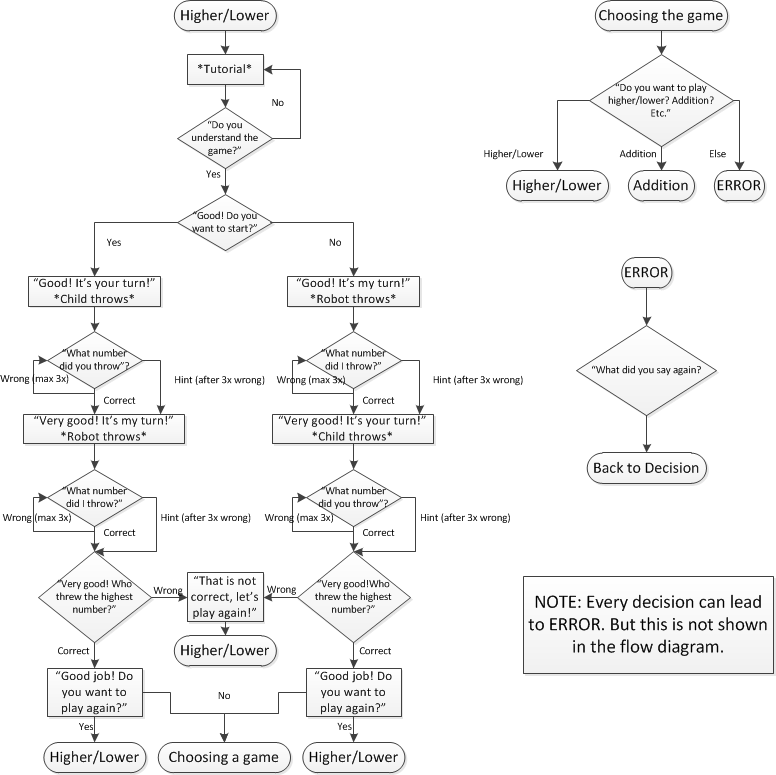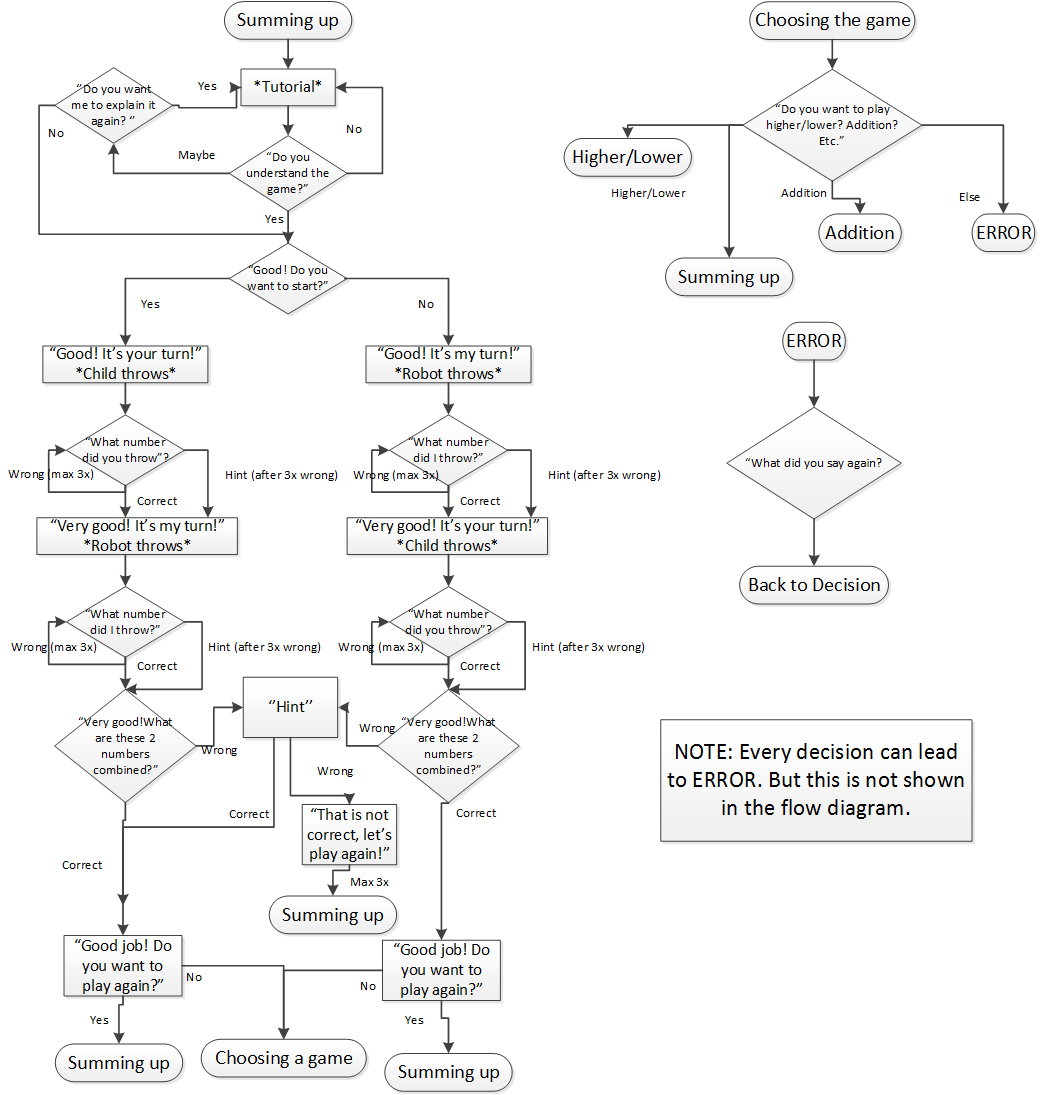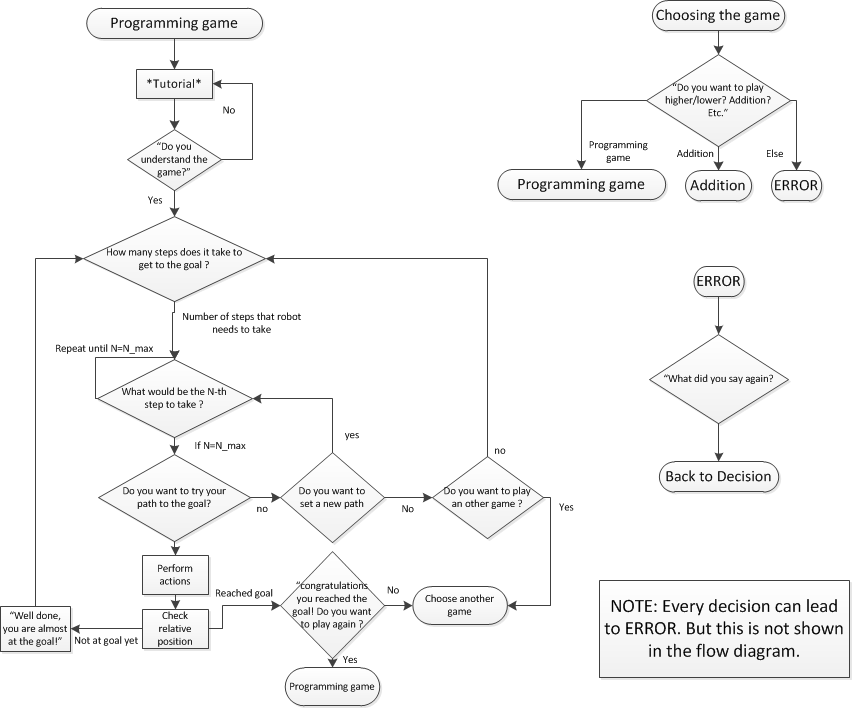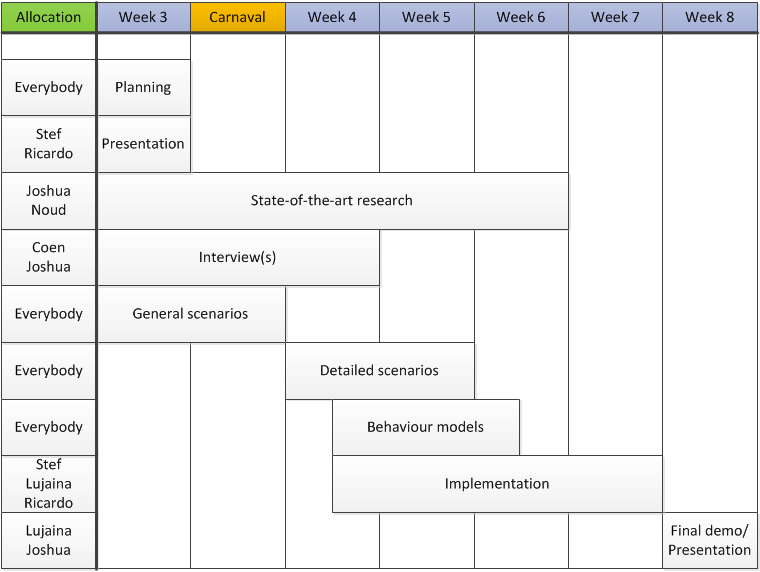PRE2016 3 Groep18
Group members
| Name | Student ID |
| L.H.M.M. Abuerban | 0926850 |
| N.J. Bennenbroek | 0954352 |
| C.R.C. van der Gracht | 0815638 |
| R.M.H van Hout | 0814519 |
| S.H.N. van der Linde | 0899183 |
| J.R. Michels | 0888603 |
Introduction
It’s the first day after summer vacation. Kids are running excitingly, at least most of them, to their classrooms. The door swings open as they rush to their seats. But instead of a human being in front of the class, the only thing they see is a robot. They are greeted by the robot, combined with a welcoming gesture.
Imagine this futuristic idea of teaching in elementary school. Teachers completely replaced by educational robots. Educational robots that can communicate with either an individual or a complete class by speaking, moving and making gestures. Artificial Intelligent software, like motion tracking and speech recognition assists within this overall communication.
Subject
A first step towards this robot-teaching concept is the use of an assistive robot. A robot as an addition to the current teachers. Today the elementary school is all about keeping children on the same level. The current teachers focuses too much on the children that needs more attention or are bad at a subject, but the children that don’t need it and are good at a subject get less attention. A robot can help these ‘better’ students to learn as much as they can. With the robot they can learn on a fun way and on a personal level, this way the children will always be motivated to learn.
Objectives
User
- Fun learning: To motivate children to learn, we want to make the learning experience more fun. That way, the child won't loathe studying and will actually enjoy it.
- Provide personalized learning experience for the students: Every child is different, but currently most of the school system is the same for every student. We want to provide a personalized learning experience for every child. Students who have trouble with the curriculum will get more time and exercise to study, while students who quickly master the material will get more advanced exercises. Students with learning disabilities can be helped easier and more direct using the robot
- Learning to understand body language: Our project will be more comprehensive than normal education games on a computer or tablet. The system will use body language from which the child can learn. For example, the robot can use a handshake when greeting the child and a thumbs up when a child is successful in a exercise.
Society
- Making young students be more comfortable with interaction with robots: It's almost impossible to picture a future where there are no robots. Even now robots are already in the home of people. Our education robot will make the children more comfortable around the robots. The child will have fun when playing (learning) with the robot and thus will feel more comfortable around robots. Because of these happy experiences with a robot, the child will feel more comfortable around robots in general.
USE aspects
Users
The primary users for this project are the children of the elementary school who use the robot. The robot has to be able to teach the children something. Children will learn faster when they are motivated, the robot uses social cues and will speak in order to motivate the child. In order to keep the child motivated a personalized learning system is needed. A personalized learning system can help motivate a child by letting him learn on his own level, for instance when the child is bad at an subject the robot helps him with that subject, to better understand it. But also when a child is smarter than what the teacher teaches him, he can learn more with the robot.
The secondary users are the teachers of the elementary school. The robot will be implemented in a classroom, so the teacher has to know how the robot works. The robot will reduce the workload for the teacher in the long run, but all the teachers have to know something about the robot.
A tertiary user can be a parent of the child. A parent wants what is best for their child, and wants that the child learns as most as he can. The robot helps the child to learn on their personal level so the child will learn as much as he is able to learn.
Society
The society will benefit from the robot, because children starts using a robot with a young age. This way they know how a robot works and know what to expect from it. In the future more and more robots will be used so a child has to be comfortable around robots.
Enterprise
The enterprise that is going to use the scenarios is TiViPE. TiViPE (Tino’s Visual Programming Environment) is a software solutions provider and offers consultancy, research, processes, documentation, architecture, and implementation. These software solutions are mostly related but not restricted to parallel and real time systems. The scenarios benefit this company because it can implement them in the Nao Robot and use it in real time. Eventually in the long goal for this project a company that makes the Nao robots will benefit of our project because more and more Nao robots are needed in the future.
Approach
The goal of our project is to make young students learn on a fun way and on a personal level, by implementing a teaching robot
We will do this in the following order
- Determine the basic objectives of the robot. What should the robot do?
- What has already been done? Explore state-of-the-art.
- Choose which robot could be implemented to fit the needs of the project, or design a new robot.
- Choose one specific task in the form of an educational game that the robot should be able to do.
- Experiment with the robot.
- Try to implement an algorithm which will make the robot able to perform the chosen task(s).
- Refine the algorithm/reformulate task robot.
State-of-the-art
Social cues and gestures
Social cues and gestures are very important in any conversation whether that is human-human interaction or human-robot interaction. For this reason, research has been made for the interaction between humans and robots. It was shown that interactions between robots and humans have resulted in better message retention. In the classroom environment, this is needed. (Chapter 6, Torta, 2014)
Appearance
To ensure that child-robot interaction is successful, it must be ensured that the children are comfortable with interacting with the robot. For that, the appearance of the robot must be carefully designed. Children respond better to human-like features but not to a completely humanoid robot appearance. (Fang-Wu Tung, 2016)
Role-switching mechanism
‘Role-switching’ as an intrinsic motivational mechanism facilitates the engagement in long-term child–robot interaction. In this study, this was done in the specific learning framework of improving knowledge and habits with regards to healthy-life styles, though the article suggests that this can be applied in other learning frameworks as well (Ros, R., Oleari, E., Pozzi, C. et al. Int J of Soc Robotics (2016)
Robots in the classroom
Most special needs schools cannot afford the NAO. The paper investigates the non-humanoid Lego Mindstorm robot as an alternative learning method for pupils with intellectual disabilities. An interview at the end concludes that three out of four students were significantly more engaged with the non-humanoid robot than the humanoid robot, whilst one student was found to be equally engaged with both robots. (Sarmad Aslam, Penny J. Standen, Nick Shopland, Andy Burton, David J. Brown. iTAG (2016)
Interviews
Interview elementary teacher in training With Eveline Engering To gather more information about how teaching is done on elementary schools and whether a robot could be implemented in this kind of education, an interview is conducted. The first person we interviewed was Eveline Engering. Currently she is studying Pabo in the ‘Fontys Hogeschool Den Bosch’ to become an elementary teacher. This is why she had much experience in different elementary classes over the last two years. She worked in the following groups: 1&2, 5, 7 and currently she is teaching in group 3 in a dutch elementary school.
The following questions were asked to gain more information about the basics of our project.
*When teaching elementary school kids, what are important (speech) patterns?
There are a few qualities that a elementary school teacher needs to have. You need to be deductive, pedagogic sensitive and of course you need to master everything you are teaching. Besides these skills and knowledge it is very important to have a good relating with your students. If you know more about your pupils you can connect the things you are teaching to their direct world, and that is very effective.
When approaching pupils it is important that no negativity is used. When for example two children are sitten near to each other and one is really paying attention and the other is doing something else, you better compliment the pupil that is doing well instead of saying the other is doing something wrong. The pupil who wasn’t paying attention will experience the compliment as something he wants too.
Another thing that is important in the educations of elementary school kids, is that the process is more important than the result. This means that the result could be worthless while the whole process was good. It is more important that the pupils learn the process to a result instead of focusing on the result. How this is done is by feed up, feedback and feedforward. In elementary schools this means that you start with feed up: telling the goal of the assignment (for example: Today we are going to finish chapter three). Next feedback will be given in the form of telling the pupils where they are at the moment (so for example: You are now at the beginning of chapter two), and finally give feed forward in the form of telling the pupils what they need to do to accomplish the goal.
*Is it important to use some kind of body language while teaching elementary school kids.
It is very important to have an open attitude. This is because all pupils need to feel fine to ask for help or anything else. Also positive gestures are important to complement what you are saying, these gestures can for example strengthen a compliment. This way they will learn to understand nonverbal gestures. While teaching gestures help to support the learning aspect by adding a visual aspect. Young children really benefit from this addition.
*Do you have the feeling that you are understaffed at the school?
Yes I do. The increased size of classes today lead to less personal education. With large groups it is hard to focus on individual pupils. Nowadays the focus is to keep level of the group at one level, this means that the education is given at a mean level. In order to get everyone to the mean level of knowledge, an extra focus of the education is on the pupils who are under this level. Because of the large groups and focus on the pupils with a lower level, kids with a higher level receive few or none support in the current elementary school system. Sometimes they need to help the kids with a lower level, or get extra assignments which they need to make without support. In this way, according to Eveline it is possible that these smart kids don’t use their full potential, which is too bad.
Not only in the class rooms it is noticeable, but as well after school. Because of the increase in group sizes and therefore also the increase of paperwork the pressure is high.
*Do you think that some kids will benefit from personal learning?
I think that personal learning will be a good thing for all pupils. When pupils are learning at their own level, learning will go most efficient. As said weak learners already get a bit extra attention, so it would be a good thing to introduce personal learning by the smarter kids.
*Which group of kids will benefit the most of personal learning?
The smart kids are less helped by today's system! So in Eveline’s view they will benefit the most when adding personal learning in our current system.
*Which subjects are most important for this group of kids to learn, and in your view can be done by a robot?
In my view only the theoretical subject can be taught by a robot like math, language and for example geography.
*Do you think that a robot in the classroom can add something in elementary school classes?
Yes, I think that a good function robot which is able to add some personal learning really can add something to elementary school classes. This because robots are really interesting for young people. I once made a robot out of cardboard and put it in front of the class and together brainstormed about the function of the robot. The whole group was really excited and enthusiastic about the robot. We called it henk and imagined it doing a lot of stuff. This was in group 7 so you can imagine what a real robot can contribute in elementary school.
*Do you think that kids will experience learning with a robot as fun learning?
Like I said in the previous question I definitely think that learning with a robot will be experienced as fun learning.
*Do you think fun learning is an effective way of teaching?
Yes I really do think that it is an effective way of learning. This I know because we use it all the time to teach children things like math and languages.
Stick to their environment.
*Do you use educational games to learn skills to kids?
We use educational games all the time, especially by the lower classes. One example of a educational game is that we throw two dices and let the kid add it up, or retract it from each other. This really learns the meaning of numbers to children. We use this around class 3 and 4, because around this age kids begin to understand what numbers are.
*Which groups are most suitable for implementing personalised learning with a robot ?
I think that every kid in every elementary school class will find the robot very interesting. But the simple educational games will be more suitable for the lower classes. The robot could be interesting for higher groups if you implement some kind of programming game to teach children to simple program a robot. You can for example maybe make a game where the kid needs to program the robot by voice. And the robot will act on this just like the kid mentioned.
General scenarios
Math helping robot by dice game.
A child throws a dice, the robot can recognizes the pips of the dice (TiViPi site) and the robot ask for instance what is the total number thrown, or what is that dice multiply by that dice if they are more advanced. This way there will always be a random factor, which is more fun for the child and doesn't get boring. Various dice games are possible, for instance some harder dice game to keep the student on a higher level. Examples of more advanced games are adding the values of multiple throws of a dice or using dices with more faces.
Spelling helping robot by making a word with blocks.
The robot says a word, and the child has to make this word with blocks, or pieces of cardboard. The robot helps the child with spelling in this way. Some sort of database is needed in this case, and to keep students on their level easier and more difficult words can be used.
Practice with speech/pronunciation words ‘repeat the word’:
Robot speaks out a certain word and child has to repeat it. Based on voice recognition the robot either accept the word, or declines it. When declined, the robot asks to repeat the word again (“one more time”). When accepted, robot reacts with positive feedback gestures (i.e. thumbs up and a smile on display ‘face’). Improvements: Words that a hard for the child (not good recognised) are repeated. Instead of only declining or accepting, intermediate states ratings are added, where difficulties with particular syllables are identified. Remarks/critics: Current level of speech recognition (not perfect) might actually be desirable, since this corresponds with It is quite plausible that there is a difference in the speech recognition of the words that lie outside the ‘fault’ of the child For instance, it is assumable that high pitched words are recognized easier by the robot than low pitched words.
Drawing and recognizing basic geometric forms and basic objects
This game can be played in two parts:
Part 1: Robot names a basic object (or a certain geometric form) and asks the child to draw it on paper. The robot then looks at the paper and checks if the drawing corresponds with the real object. Here, memorisation words & connection/linking them with their shapes and drawing skills of the child is tested. Distinguishing difficulties in this 2 learning areas might be done as follows: the child is first asked to draw the object himself. If the YOLO dataset doesn’t recognise the drawing (not drawn good enough), the robot gives the child a diagram/table with possible pictures, where one corresponds with the real object.
Part 2: Now, the roles are exchanged in the sense that now, the robot shows a picture of a certain object to the child. Then, the child is asked to name the certain object. If he/she doesn’t know the name, the robot says n words, and the child has to the pick the right one.
Detailed scenarios
Math helping robot by a dice game (higher lower)
Math helping robot by dice game (summing up) =
Spelling helping robot by making a word
Maze programming game
A concept educational game is made to challenge the smarter kids of elementary school from classes 7 and 8. This game makes it possible to let the kids program the robot by voice. The idea is that the robot stands on a table with some kind of physical maze which has tiles and walls. The robot will move through the maze. This movement will be decided by the kid. The goal of the game is that the robot reaches the finish tile in the maze.
The pupil can program the robot with a secual of actions. If the goal is not reached after this secual another secual of moves can be programmed by the kid. This will continue until the goal is reached.
The simple state diagram of this game is displayed below.
Planning
Milestones
- Planning
- State-of-the-art research
- General scenarios
- Interview with elementary school teacher(s)
- Detailed scenarios
- Behaviour models
- Final demo
Planning
Deliverables
- Wiki:
- Rationale of the project
- Stakeholders & USE aspects
- Research
- State-of-the-art
- Interview(s)
- Our process
- Scenarios
- Code
- Demo (simulation/real life)
Logbook
Week 1
- Brainstorm session
- Discussion about the possible topics for this course
- Come to a decision about the topic
- Make the idea more concrete such that everyone in the team knows what we will be doing further on. We have made an initial list of objectives and approach.
Week 2
- Had a meeting with one of the professors of the course and two of the team members. This was to ensure that the idea was sufficient for this course and that it was also feasible. Within this meeting it was discussed whether we are able to use the Nao robot for the purposes of our project. Furthermore, some extensions were discussed. A follow-up meeting will be scheduled to further discuss this.
- Preparations for the presentation were made and the decision of who will be presenting for the first, and the later, presentations were also made.
Week 3
- We redefined our goals and our subject after the meeting with Tino Lourens. And we set up the milestones and made the planning
- The second presentation was made which holds the milestones, planning and the deliverables.
Week 4
- An interview was done with an elementary school teacher in training, who had teached group 1&2, 3 and 7. She was very positive about the our idea.
- Another interview was done.
- We came up with more scenarios which we are going to work out further.
- We made 2 detailed scenarios.
- Feedback session:
Week 5
- Weekly feedback sessions
Week 6
- Weekly feedback sessions
Week 7
- Weekly feedback sessions
Week 8
- Final presentation
References
- Torta, E. (2014). Approaching independent living with robots Eindhoven: Technische Universiteit Eindhoven DOI: 10.6100/IR766648
- Fang-Wu Tung (2016) Child Perception of Humanoid Robot Appearance and Behavior, International Journal of Human–Computer Interaction, 32:6, 493-502, DOI: 10.1080/10447318.2016.1172808
- Ros, R., Oleari, E., Pozzi, C. et al. Int J of Soc Robotics (2016) 8: 599. doi:10.1007/s12369-016-0356-9



